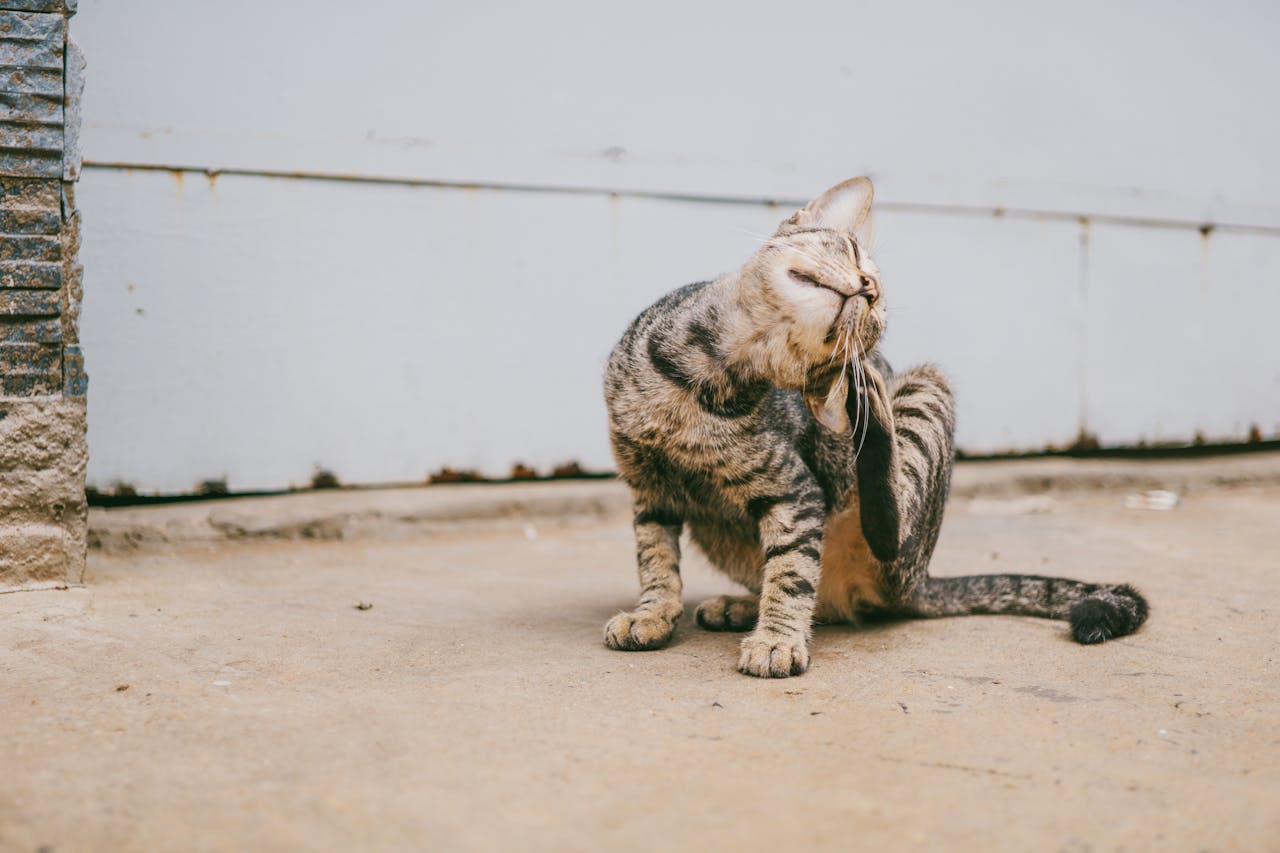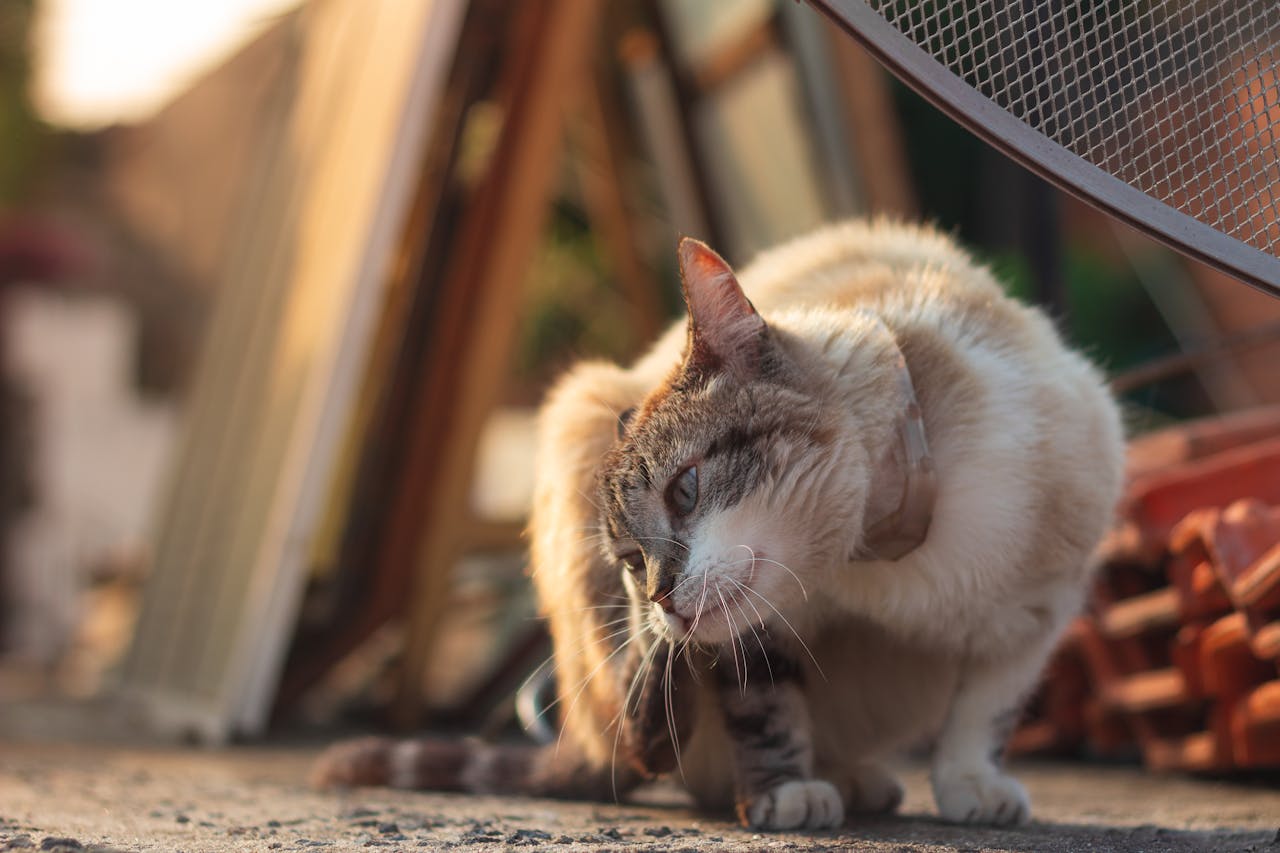“Ask a Vet” Question
“My cat has been scratching itself raw, especially around her neck and face. She’s losing fur on her lower back near her tail and has scabs on her neck, but I haven’t found any fleas. Also, she seems to have dry skin. I’m worried she might hurt herself from all the scratching. What could be causing this, and are there safe remedies I can try at home? Should I see a vet?”
Answer:
Itching is uncommon in cats and, since cats go to the vet a lot less often than dogs, you should know about all the causes of itching in cats for the best chances of success when treating at home.
Causes of Itching in Cats
The most common causes of itching in cats are:
- Flea Allergy Dermatitis
- Inhalant Allergies
- Food Allergy
- Lice, Ticks, and Mites
- Lupus, Pemphigus, and Other Autoimmune Skin Diseases
- Flea Allergy Dermatitis
Flea Allergy Dermatitis
This is still the most common cause of itching in cats. Unlike dogs, cats can have flea infestations where the flea dirt and fleas are never seen, as cats will often eat the flea during normal grooming. In one study of outside cats, over 70% of them were infected with fleas. If you have seen tapeworm segments in your cat’s stool, it is because she has been eating fleas.
Inhalant Allergies
This is the second most common cause of itching in cats. Pollens are the most common allergens. Eighty-two percent of cats had non-seasonal allergies. So, even if a cat is not outside, the allergies may be caused by cockroach dust, house mites, and other allergens normally in even the cleanest house (1). About a fourth of allergic cats also had flea allergies, so until that problem is resolved, the cat is not going to get better.
Food Allergy
Some cats will have vomiting and other GI signs. But the only thing you might see is itching, scratches, red skin, and ear infections. Estimates vary, but about 13% of itching cats have food allergies.
Lice, Ticks, and Mites
These skin parasite infections are pretty uncommon in cats now, but if your pets go outside, you should consider them. Ear mites were found in almost 20% of outdoor cats and ticks in 18%, but only about 1% had lice (2). Ear mites can cause severe itching around the head.
Lupus, Pemphigus, and Other Autoimmune Skin Diseases
If your cat has a serious skin infection or deep lesions from scratching, he or she will need a veterinary examination and possibly other treatment. The autoimmune skin diseases are not an emergency, but the sooner you get treatment for these, the better for your pet.
Why Your Cat Is Scratching Itself Raw
Many of the above causes of itching will lead to scratches and wounds on the cat’s skin, a condition known as miliary dermatitis. This article will also include tips on how to treat this at home, but the first thing you need to do is figure out which of those causes on the list is responsible for the itching.
What to Know About Flea Control
Before you start treating any of these causes for an itchy cat, you need to understand that you need to keep your cat inside. There are many reasons that you should start keeping your cat indoors. One of them is that fleas and other parasites will be difficult to control if your cat still gets out. Look into building a catio if you live in your own home. I have also seen excellent balcony conversions for cats that live in an apartment. So, if you have a long-term lease or own your own apartment, you should look into converting the balcony so your cat can have an enclosed outdoor space.
Is the Cat Losing Hair on Its Back Near the Tail?
If you have seen tapeworm segments in your cat’s stool, it is because she has been eating fleas, which may cause itching and hair loss near the tail.

Some Ways to Rid Your Cat of Fleas at Home
Look at the most common causes of itching, but get rid of a possible flea infestation first. Some of the other things you can do to get rid of any flea infestation include:
- Prescription Flea Control Products: In many countries, you can order a good topical flea preventative online without needing a prescription. However, they are not available without a prescription in the U.S. So, if you are there, you may need to consider ordering from a Canadian or Australian website. Bravetco lasts three months but is relatively expensive, so most cat families prefer the more affordable options like Frontline.
- Vacuum the House: You can remove most flea eggs and larvae by vacuuming the house. Be sure to remove and throw out the bag so the fleas do not hatch there and re-infest the house.
- Non-Prescription Flea Products: If you do not have the prescription products available where you live, and cannot order from a Canadian or Australian website, you can purchase flea control products at your local pet store or a flea collar from Amazon. I recommend the Hartz UltraGuard Flea & Tick Collar. These products are a lot less expensive than prescription products but they are not as effective.
- Flea Shampoo: Most cats do not like baths, but if your cat is an exception, you can purchase products in pet stores to kill the fleas on your cat. Be sure to purchase a flea comb to use after the bath to remove any stunned fleas that are not yet dead.
Next Steps if Your Cat Is Scratching Itself Raw
If your cat is scratching itself raw, it could be due to fleas, allergies (inhalant or food-related), skin parasites like mites, or even autoimmune skin diseases. Start by addressing possible flea infestations and improving your cat’s environment. In my next post, I’ll offer some safe home remedies for itchy cat skin. Please consult a vet if symptoms persist or worsen.




